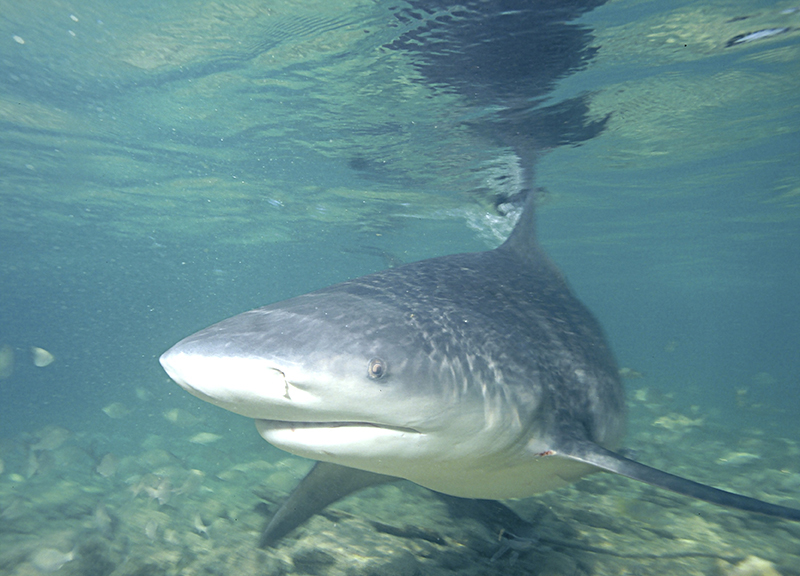MOORE OUTDOORS: Yes, there are sharks in Neches
Published 11:45 pm Saturday, December 10, 2016

- Bull sharks are present in local river systems and have been caught in Bessie Heights Marsh in the past. (Courtesy photo)
Recently a reader asked if there were sharks in the local river systems.
The answer is “yes”.
Bull sharks are extremely freshwater tolerant and have been caught as far north as the Mississippi River in Illinois. Sabine Lake has a healthy population of bull sharks in the summer and one of the areas anglers encounter them the most is near Stewts Island, which is near the mouth of the Neches River.
Trending
Over the years we have run photos of small bull sharks caught in Bessie Heights Marsh (on the Neches River). I personally witnessed a shark feeding behind a shrimp boat that was trawling on the east end of Middle Pass, which is on the southern tip of the Sabine River.
How common are they? No one really knows but their presence in summer months is undeniable.
•
Every few months we address reader questions, and this week we will hit a few interesting ones that came my way over the last six weeks:
Q: Why do states like Kansas and New York ban hog hunting? How do they expect to control their numbers?
A: Both states feel the biggest reason feral hog populations spread is because of hunters moving them and release them on properties to hunt. And that is probably 100 percent accurate.
Trending
Over the years thousands of hogs were moved in Texas and stocked on various ranches both high and low fence and of course they do not abide by property boundaries or fences for that matter. Hogs were brought to the United States by Spanish explorers in the 1500s and Texas along with Florida got the first dose of them.
For the most part, up until the 1990s they were mainly restricted to creek bottoms in East Texas, the Hill Country and South Texas. Now they are everywhere.
Both Kansas and New York plan on doing focused hog trapping and Kansas officials are shooting hogs from helicopters along their Oklahoma border. Banning hunting in Texas would never work because hogs are here to stay no matter what we do.
In those states, the jury is still out on their plan of action.
Q: How come no one squirrel hunts anymore?
A: Squirrel hunting used to be so popular in East Texas than many schools would let out on opening day. Very few Texas hunters pursue squirrels and the reasons are probably multi-faceted.
Attention beginning in the 1970s started shifting toward deer hunting and up until that point deer had been rare in East Texas since at least the 30s.
Also, leasing prices started to skyrocket in the 90s and most of the leasing was for deer. Some leases do not like squirrel hunting going on while deer are in season.
Q: Is it true there was a Sharelunker 13-pound-plus bass caught in Spindletop Bayou near Winnie?
A: I have seen that entry, and no there was not a Sharelunker caught in Spindletop Bayou. There was one caught in Spindletop Reservoir located off of Spindletop Bayou. That was a highly managed lake that had some huge fish in it and I had the privilege of fishing years ago.
Hurricane Ike pretty much destroyed it so you don’t hear much from there anymore.
In fact, I joke that four pounders are “Adams Bayou Sharelunkers”.
Q: Is it true that blood trailing dogs are not legal to use in Southeast Texas?
A: Although these dogs are effective, they are indeed not actually legal in all parts of the state.
For example, it is illegal to use dogs to trail wounded deer in Angelina, Hardin, Jasper, Nacogdoches, Newton, Orange, Sabine, San Augustine, Shelby, and Tyler counties. These were the core counties for deer-dog hunting which has long-since been banned but still has a remnant that pursue them in that fashion.
According to the Texas Parks & Wildlife Department, “A person is prohibited from using a dog to hunt or pursue deer in this state. A person who violates this law is subject to a fine of $500-$4,000 and/or a year in jail.”
Additionally, a person’s hunting and fishing licenses may be revoked or suspended. In addition, no person may possess a shotgun and buckshot or slugs while in the field with dogs on another person’s land during an open deer season in the counties listed above.
The reason for this law is that illegal hunting of (non-wounded) deer still exists in East Texas.
Many law-abiding hunters believe the law is antiquated and prohibits them from doing everything they can to find their deer.
“The counties where the ban is in place, especially in the southeastern pocket are some of the thickets spots in the state and it can be hard to find even a mortally hit deer. If we could use dogs under the same guidelines the rest of the state has it would be a big help to us down here. The people who run dogs illegally are going to use dogs whether we use trailing dogs anyway,” said a hunting club manager who requested to remain anonymous.
The guidelines he spoke of are that no more than two dogs may be used to trail a wounded deer. A “wounded deer” is a deer leaving a blood trail according to TPWD.
•
To contact Chester Moore, email him at chester@kingdomzoo.com.






